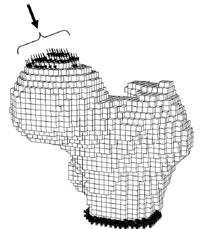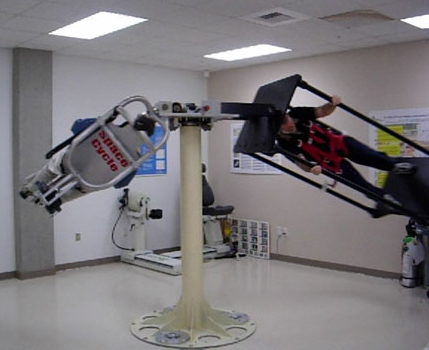Studies on the weakened bones of astronauts are hardly new-- we've known that prolonged time in zero gravity effects the bones and muscles of astronauts for as long as we've been putting them in orbit. The reason for this is that the cells responsible for bone maintenance are very sensitive to the force signal of our body's response to gravity. Vastly simplified, the bone repairs its structure using two complementary sets of cells. The purpose of the osteoclast is to march around digesting old bone material, leaving a small void in its wake. This gap is then filled by osteoblasts, which build mineral-dense new bone to replace the old.
The everyday processes of living in the earth's gravitational field-- walking, jumping, even sitting-- provide our bones with daily damage in the form of microcracks. In inert materials like ceramics, microcracks are a big problem-- they provide multiple tiny points where stress spikes, leading to large cracks, material degradation, and hastened failure. The human body uses these heightened stress points to signal osteoclasts to flock to the area, resorbing the microcracks and making way for osteoblast remodeling. Thus microdamage is an important part of our self-healing process-their stress buildup signals our osteoclasts that their service is needed.
 In zero gravity, astronauts' bones don't experience enough stress to signal for remodeling. This results in a well-documented loss in bone density, but density is a somewhat indirect measure of bone strength. Keyak's work takes a different approach to quantifying bone strength loss. By using QCT scans, she constructed individualized pre- and post-flight finite element models of the femur and hipbones of thirteen astronaut subjects. Each of these astronauts maintained a strict regimen of resistance and cycling exercise on the space station, but Keyak's work suggests that it wasn't enough. Subtle changes in their bone structure reveal that the strength of these bones, loaded in standing position, has decreasesed to osteoporitic values.
In zero gravity, astronauts' bones don't experience enough stress to signal for remodeling. This results in a well-documented loss in bone density, but density is a somewhat indirect measure of bone strength. Keyak's work takes a different approach to quantifying bone strength loss. By using QCT scans, she constructed individualized pre- and post-flight finite element models of the femur and hipbones of thirteen astronaut subjects. Each of these astronauts maintained a strict regimen of resistance and cycling exercise on the space station, but Keyak's work suggests that it wasn't enough. Subtle changes in their bone structure reveal that the strength of these bones, loaded in standing position, has decreasesed to osteoporitic values. Despite the similarities, it's not time to make astronauts the new poster-children for osteoporosis. The bone strength and density losses are comparable, but the causes are different. Osteoporosis on a cellular level involves the deployment of osteoblasts, but an insufficient deployment of osteoclasts. This results in a bone with increased porosity. Astronauts, on the other hand, lose their bone strength the same way that you and I might lose it if we quit our jobs and watched TV all day-disuse. This means that osteoporosis drugs such as biophosphonates, which stave off osteoclast action to maximize bone density retention, are not much help to astronauts.
The solution to less gravity? More gravity. Keyak and other researchers at UC Irvine have developed the Space Cycle, a human-sized centrifuge that looks a lot like something you'd see at an amusement park. The Space Cycle simulates gravitational acceleration by swinging its occupant in a circular path, creating a centrifugal force that is indistinguishable from gravity. This would permit even the occupants of the space station to perform excercises such as squats in earth-like (or greater-than-earthlike) acceleration, activating the bone-remodeling response that we enjoy here on earth.

Keyak JH, et al., Reduction in proximal femoral strength due to long-duration spaceflight. Bone (2009), doi:10.1016/j. bone.2008.11.014
http://spacecycle.hs.uci.edu/




Comments